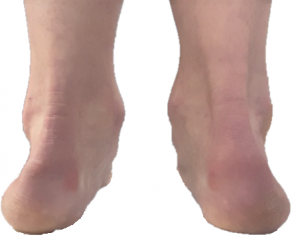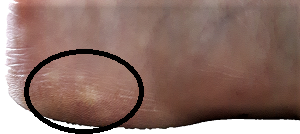
Calcaneal Fat Pad Contusion/Fat Pad Syndrome
What is it?
Calcaneal fat pad contusion, or fat pad syndrome, occurs when the fat pad under the heel becomes irritated. There is a fat pad that sits under the heel to protect the bone while walking and standing. When this fat pad shifts around, it exposes the heel bone (calcaneus) causing more pressure/less cushioning. Pain may develop at the bottom, or around the sides of the heel. While standing, the fat pad shifts out to the sides and pushes against the side of the heel.
Causes
Age
Over time, the fat pad starts to wear down or atrophy, leading to calcaneal fat pad contusion. This can be accelerated by the factors below.
Specific Activities
Hard surfaces, especially in combination with hard shoes, can eventually irritate the fat pad. This can be at work, daily activities or even during exercise. Some examples of this are safety shoes on concrete floors, barefoot at home on hardwood floors, or running on the sidewalk with hard soled shoes.

Mechanics
The way your feet move can make an impact on the heel fat pad. With pronation (rolling in), the heel moves side to side creating shear. With supination (rolling out), there could be a lack of shock absorption, and/or improper weight distribution at the heel, shifting the fat pad to one side.
Trauma
An impact to the heel can lead to a calcaneal fat pad contusion. This impact can be minor, such as stepping on an object, or severe, such as a fall from a height. A minor impact may be many minor impacts over time, such as hiking on an uneven surface. When there is a severe impact, be aware that a calcaneal (heel) fracture may occur. Visit a physician to confirm if a facture is present, especially if there is bruising.
What will I feel and see?
Most people feel a bruised heel, or like they are walking on the bone without cushioning. It is different than plantar fascia pain, as the plantar fascia presents as pain at the front of the heel, where the calcaneal fat pad contusion presents as pain at the very bottom, or even around the sides of the heel.

A visible sign of calcaneal fat pad contusion are white bumps on the side of the heel when standing/weight bearing. This may not be present in all cases. These bumps are the fat cells pushing against the side of the heel. Because these bumps appear at the back and sides of the heel, it is best seen by another person.
Pedorthic Treatments
Orthotics
Orthotics help with calcaneal fat pad contusion through support and cushioning. In addition to added heel cushioning, a deep heel cup on the orthotic helps to contain the natural fat pad under the heel. Support on the orthotic helps to prevent any heel shearing by preventing the heel from shifting around. Depending on factors such as the severity, mechanics and cause of the pain, an over the counter insert or custom orthotic may be recommended.
Footwear
Proper footwear is important to prevent and relieve pain through support and cushioning.
An important part of shoe support is the heel counter. This is the area directly behind and to the sides of the heel. There should be a solid piece to prevent the heel from moving around and to cup the heel. A solid base is also important to prevent the foot from moving around too much. This can be tested by bending the shoe in half. The shoe should not bend in half through the middle.
Cushioning is also important, especially on hard surfaces. Look for a cushioned shoe through the midsole. The midsole should be thick, and you should be able to depress your thumb in slightly with a hard push. Be aware that shoes can be cushioned and supportive at the same time.
In some cases, certain footwear is required and it may be difficult to find the proper footwear for your pain. In this case, try to minimize the amount of time on your feet, step/stand on softer surfaces when possible, and look into supportive inserts.
If it sounds like the condition you have, or you would like more information, feel free to contact us!

You must be logged in to post a comment.